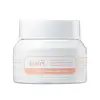What's inside
What's inside
 Key Ingredients
Key Ingredients

 Benefits
Benefits

 Concerns
Concerns

 Ingredients Side-by-side
Ingredients Side-by-side

Water
Skin ConditioningAvena Sativa Kernel Flour
AbrasiveKaolin
AbrasiveBentonite
AbsorbentGlycerin
HumectantCanadian Colloidal Clay
Skin ConditioningStearic Acid
CleansingCetearyl Alcohol
EmollientCI 77891
Cosmetic ColorantPentylene Glycol
Skin ConditioningTriethanolamine
BufferingGlyceryl Stearate Se
EmulsifyingCetyl Ethylhexanoate
EmollientMagnesium Aluminum Silicate
AbsorbentMethylparaben
PreservativePhenoxyethanol
PreservativeCI 77288
Cosmetic ColorantPropylparaben
PreservativeButylene Glycol
HumectantSaccharide Isomerate
HumectantAllantoin
Skin ConditioningXanthan Gum
EmulsifyingMelaleuca Alternifolia Leaf Oil
AntioxidantDisodium EDTA
Portulaca Oleracea Extract
Skin ConditioningWater, Avena Sativa Kernel Flour, Kaolin, Bentonite, Glycerin, Canadian Colloidal Clay, Stearic Acid, Cetearyl Alcohol, CI 77891, Pentylene Glycol, Triethanolamine, Glyceryl Stearate Se, Cetyl Ethylhexanoate, Magnesium Aluminum Silicate, Methylparaben, Phenoxyethanol, CI 77288, Propylparaben, Butylene Glycol, Saccharide Isomerate, Allantoin, Xanthan Gum, Melaleuca Alternifolia Leaf Oil, Disodium EDTA, Portulaca Oleracea Extract
Glycerin
HumectantSucrose
HumectantCetyl Ethylhexanoate
EmollientButyrospermum Parkii Butter
Skin ConditioningCaprylic/Capric Triglyceride
MaskingCetyl Alcohol
EmollientGlucose
HumectantCitrus Paradisi Fruit Extract
Skin ConditioningMicrocrystalline Wax
Emulsion StabilisingGlyceryl Stearate
EmollientSorbitan Stearate
EmulsifyingOlea Europaea Fruit Oil
MaskingSorbitan Sesquioleate
EmulsifyingPEG-100 Stearate
Simmondsia Chinensis Seed Oil
EmollientCellulose
AbsorbentCalamine
AbsorbentTocopheryl Acetate
AntioxidantRubus Idaeus Seed Oil
EmollientKaolin
AbrasiveQuartz
Abrasive1,2-Hexanediol
Skin ConditioningBisabolol
MaskingCitrus Grandis Peel Oil
MaskingButylene Glycol
HumectantLimonene
PerfumingGlycerin, Sucrose, Cetyl Ethylhexanoate, Butyrospermum Parkii Butter, Caprylic/Capric Triglyceride, Cetyl Alcohol, Glucose, Citrus Paradisi Fruit Extract, Microcrystalline Wax, Glyceryl Stearate, Sorbitan Stearate, Olea Europaea Fruit Oil, Sorbitan Sesquioleate, PEG-100 Stearate, Simmondsia Chinensis Seed Oil, Cellulose, Calamine, Tocopheryl Acetate, Rubus Idaeus Seed Oil, Kaolin, Quartz, 1,2-Hexanediol, Bisabolol, Citrus Grandis Peel Oil, Butylene Glycol, Limonene
 Reviews
Reviews

Ingredients Explained
These ingredients are found in both products.
Ingredients higher up in an ingredient list are typically present in a larger amount.
Butylene Glycol (or BG) is used within cosmetic products for a few different reasons:
Overall, Butylene Glycol is a safe and well-rounded ingredient that works well with other ingredients.
Though this ingredient works well with most skin types, some people with sensitive skin may experience a reaction such as allergic rashes, closed comedones, or itchiness.
Learn more about Butylene GlycolCetyl Ethylhexanoate is an emollient ester. It comes from cetearyl alcohol and 2-ethylhexanoic acid.
Cetyl Ethylhexanoate is an emollient that adds a velvety feel to skin without being greasy or oily. Emollients help trap moisture into your skin, keeping your skin soft and hydrated.
Glycerin is already naturally found in your skin. It helps moisturize and protect your skin.
A study from 2016 found glycerin to be more effective as a humectant than AHAs and hyaluronic acid.
As a humectant, it helps the skin stay hydrated by pulling moisture to your skin. The low molecular weight of glycerin allows it to pull moisture into the deeper layers of your skin.
Hydrated skin improves your skin barrier; Your skin barrier helps protect against irritants and bacteria.
Glycerin has also been found to have antimicrobial and antiviral properties. Due to these properties, glycerin is often used in wound and burn treatments.
In cosmetics, glycerin is usually derived from plants such as soybean or palm. However, it can also be sourced from animals, such as tallow or animal fat.
This ingredient is organic, colorless, odorless, and non-toxic.
Glycerin is the name for this ingredient in American English. British English uses Glycerol/Glycerine.
Learn more about GlycerinKaolin is a clay. It is used for oil control and to help minimize pores. Like other clays, kaolin has the ability to absorb excess sebum or oil. This can help clean out pores and mattify the skin.
Some types of kaolin may have exfoliating properties. When water is added to kaolin, it becomes a paste with small abrasive particles.
Most kaolin is a white color, but may be pink/orange/red depending on where it comes from.
The name 'kaolin' comes from a Chinese village named 'Gaoling'. Kaolin clay comes from rocks rich in kaolinite. Kaolinite, the mineral, has a silicate layered structure. Kaolinite is formed from chemical weathering of aluminum siilicate minerals.
Besides skincare, kaolin is commonly used to make glossy paper, in ceramics, toothpaste, and as medicine to soothe stomach issues.
Learn more about Kaolin